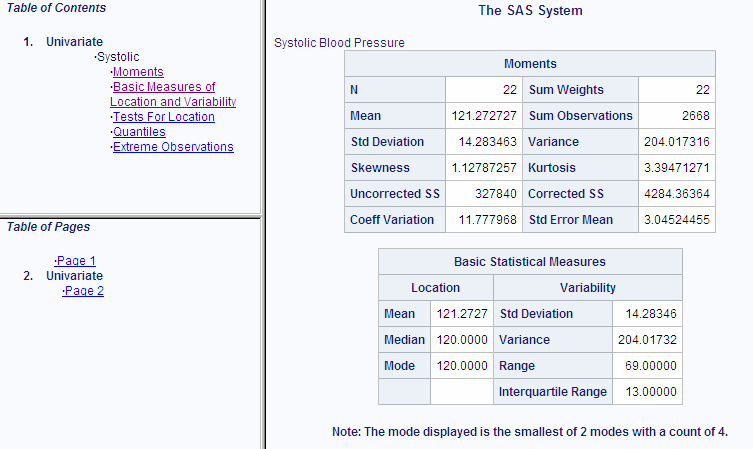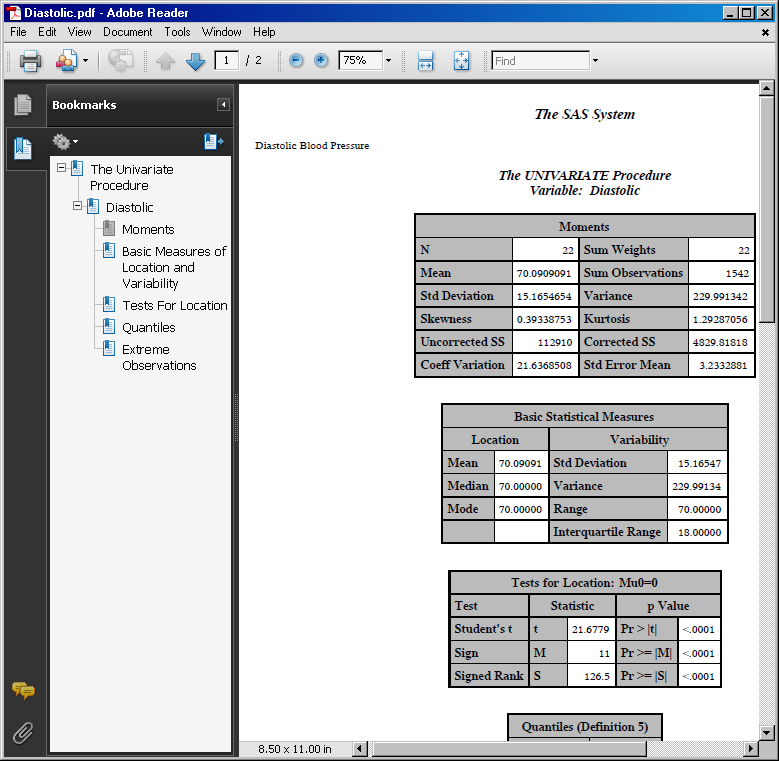ODS EXCLUDE Statement
Specifies output objects to exclude from ODS destinations.
| Valid in: | Anywhere |
| Category: | ODS: Output Control |
Syntax
Required Arguments
- exclusion(s)
-
specifies one or more output objects to add to an exclusion list.By default, ODS automatically modifies exclusion lists at the end of a DATA step that uses ODS, or at the end of a procedure step. For information about modifying these lists, see Selection and Exclusion Lists .
- output-object
-
specifies one or more output objects to exclude. To specify an output object, you need to know which output objects your SAS program produces. The ODS TRACE statement writes to the SAS log a trace record that includes the path, the label, and other information about each output object that is produced. You can specify an output object in any of the following ways:
-
a partial path. A partial path consists of any part of the full path that begins immediately after a period (.) and continues to the end of the full path. For example, suppose the full path is the following:
Univariate.City_Pop_90.TestsForLocation
Then the partial paths are as follows:City_Pop_90.TestsForLocation TestsForLocation
-
a partial label path. A partial label path consists of any part of the label that begins immediately after a period (.) and continues to the end of the label. For example, suppose the label path is the following:
"The UNIVARIATE Procedure"."CityPop_90"."Tests For Location"
Then the partial label paths are as follows:"CityPop_90"."Tests For Location" "Tests For Location"
See:ODS TRACE Statement.
- ALL
-
specifies that ODS does not send any output objects to the open destination.Alias:ODS EXCLUDE DEFAULTInteraction:If you specify ALL without specifying a destination, ODS sets the overall list to EXCLUDE ALL and sets all other lists to their defaults.Tips:Using ODS EXCLUDE ALL is different from closing a destination. The destination remains open, but no output objects are sent to it.
To temporarily suspend a destination, use ODS SELECT NONE. Use ODS SELECT ALL when you want to resume sending output to the suspended destination.
- NONE
-
specifies that ODS send all of the output objects to the open destination.Interaction:If you specify the NONE argument without specifying a destination, ODS sets the overall list to EXCLUDE NONE and sets all other lists to their defaults.Tips:ODS EXCLUDE NONE has the same effect as ODS SELECT ALL.
To temporarily suspend a destination, use ODS SELECT NONE. Use ODS SELECT ALL when you want to resume sending output to the suspended destination.
Optional Arguments
- ODS-destination
-
specifies to which ODS destination's exclusion list to write, where ODS-destination can be any valid ODS destination. For a discussion of ODS destinations, see Understanding ODS Destinations.Default:If you omit ODS-destination, ODS writes to the overall exclusion list.Tip:To set the exclusion list for the output destination to something other than the default, use the ODS OUTPUT Statement .
- WHERE=where-expression
-
excludes output objects that meet a particular condition. For example, the following statement excludes only output objects with the word “Histogram” in their name:
ods exclude where=(_name_ ? 'Histogram');
- where-expression
-
is an arithmetic or logical expression that consists of a sequence of operators and operands. where-expression has this form:(subsetting-variable <comparison-operator where-expression-n> )
Example: Conditionally Excluding Output Objects and Sending Them to Different Output Destinations
| Features: |
ODS EXCLUDE statement:: Options: ODS-Destination, WHERE=
|
| Other features: |
PROC UNIVARIATE |
Program
options nodate;
data BPressure;
length PatientID $2;
input PatientID $ Systolic Diastolic @@;
datalines;
CK 120 50 SS 96 60 FR 100 70
CP 120 75 BL 140 90 ES 120 70
CP 165 110 JI 110 40 MC 119 66
FC 125 76 RW 133 60 KD 108 54
DS 110 50 JW 130 80 BH 120 65
JW 134 80 SB 118 76 NS 122 78
GS 122 70 AB 122 78 EC 112 62
HH 122 82
;
run;
ods html text='Systolic Blood Pressure' file='Systolic-body.html'
frame='Systolic-frame.htm'
contents='Systolic-contents.htm'
page='Systolic-page.htm';
ods pdf file='Diastolic.pdf' text='Diastolic Blood Pressure' startpage=no;
ods html exclude where=(_path_ ? "Diastolic" ) ; ods pdf exclude where=(_path_ ? "Systolic" ) ;
proc univariate data=BPressure;
var Systolic Diastolic;
run;
ods html close;
ods pdf close;
Program Description
options nodate;
data BPressure;
length PatientID $2;
input PatientID $ Systolic Diastolic @@;
datalines;
CK 120 50 SS 96 60 FR 100 70
CP 120 75 BL 140 90 ES 120 70
CP 165 110 JI 110 40 MC 119 66
FC 125 76 RW 133 60 KD 108 54
DS 110 50 JW 130 80 BH 120 65
JW 134 80 SB 118 76 NS 122 78
GS 122 70 AB 122 78 EC 112 62
HH 122 82
;
run;
ods html text='Systolic Blood Pressure' file='Systolic-body.html'
frame='Systolic-frame.htm'
contents='Systolic-contents.htm'
page='Systolic-page.htm';Exclude output objects from different output destinations.The first ODS EXCLUDE statement excludes from the
HTML destination output objects that have 'Diastolic' in the pathname.
The second ODS EXCLUDE statement excludes from the PDF destination
output objects that have 'Systolic' in the pathname.
Create the output objects.As PROC UNIVARIATE sends each output object to the Output Delivery
System, ODS does not send the output objects from PROC UNIVARIATE
that match the items in the exclusion list to the open destinations.
Close the HTML destination.The ODS HTML CLOSE statement closes the HTML destination and all
the files that are associated with it. If you do not close the destination,
then you will not be able to view the HTML file specified by the FRAME
attribute until you close your SAS session.

